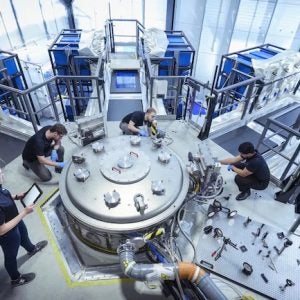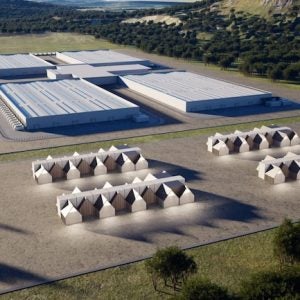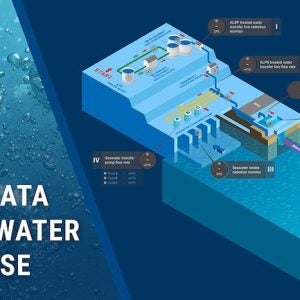The President of Brazil’s National Nuclear Energy Commission (CNEN – Comissào National de Energia Nuclear), Francisco Rondinelli Jr, during a visit to Argentina, signed a Memorandum of Understanding (MOU) with the President of the Argentine Atomic Energy Commission (CNEA – Comisión Nacional de Energía Atómica), Adriana Serquis, to strengthen bilateral cooperation in the peaceful use of nuclear technology.
CNEA said the MOU constitutes a new bilateral collaborative milestone based on the agreement signed with CNEN in 2011 and the relaunch of the strategic alliance between Brazil and Argentina, agreed in January by Argentina President Alberto Fernández and Brazilian Presidernt Luiz Inácio Lula Da Silva.
The document related to the production of radioisotopes, irradiation tests of fuels and materials, in addition to research involving neutron beams and continued co-operation in development of the Brazilian Multipurpose Reactor (RMB – Reator Multipropósito Brasileiro), which is based on Argentina’s RA-10 research reactor. Also present were Brazil’s Minister of Science, Technology & Innovation, Luciana Barbosa de Oliveira Santos, and the Minister of Science of Argentina, Daniel Filmus.
Filmus welcomed integration with Brazil. “ We are excited by the Minister's effort to be here at a difficult time where the existence of science itself is being questioned. Barbosa de Olivera Santos said: “ I am very happy to see that we are transforming what we planned at the beginning of the year into concrete actions. It took place through the eight subprogrammes that we define as priorities for bilateral cooperation, but with special success in nuclear cooperation, such as RA-10 and RMB, and in space cooperation with the Sabia-MAR ”.
CNEN said the RMB represents national autonomy in the manufacture of radioisotopes essential for the treatment of diseases such as cancer and in diagnostic imaging. “Argentina has experience in the construction of radioisotope production facilities, construction of reactors, production processes and technical knowledge that adds value to the Brazilian project,” CNEN said in a statement. In addition, “exchanges with Brazilian professionals will contribute to the generation of knowledge, technological development and innovation in the region”.
CNEN President Rondinelli said: “The two institutions, CNEN and CNEA, work in the development of nuclear applications for peaceful purposes and have a lot to cooperate with each other for the development of the sector in both countries.” He noted that the MOU includes a partnership with private Argentine company INVAP, for engineering support for the RMB and laboratory facilities for research, processing and testing of materials. The RMB is anticipating investments of BRL1bn ($194m) by 2026.
CNEA President Serquis, welcoming the visitors, highlighted the long and close relationship with Brazil on nuclear issues. “We have had an agreement between the two countries for years during which we established the RA-10, our multi-purpose reactor, as a similar project to the RMB…. This memorandum of understanding that we signed with CNEN, will help to strengthen that mutual collaboration”.
Following the signing of the MOU, the Brazilian delegation visited Argentina’s RA-10 reactor at the Ezeiza Atomic Centre, which is scheduled to start operating in 2025. The facility is expected to supply 20% of the world demand for molybdenum-99. Brazil’s Science Minister Barbosa de Olivera Santos noted that Argentina is internationally recognised for its competence in developing radioisotope production plant projects “and we want to have that experience in the construction of our Brazilian multi-purpose reactor".
The RA-10 is a 30 MWt open-pool research reactor for production of radioisotopes for medicinal and industrial use, with the capacity to meet a good part of the demand in Latin America. Will produce doped silicon, the highest quality raw material for the development of advanced electronic applications, and sources of industrial iridium for the evaluation of the integrity and quality of large-scale constructions. It will also enable research in basic sciences through the use of advanced neutron techniques, and in other fields such as pharmaceuticals, materials and biotechnology. The RA-10 will replace the RA-3 reactor, a 10 MWt pool-type reactor which began operations in 1967. The reactor is scheduled to be operating in 2025.
INVAP signed an agreement in 2013 to build the two research reactors one on Argentina (RA-10) and one in Brazil (RMB) with the reference design to be the Open Pool Australian Light-water research reactor that INVAP supplied to the Australian Nuclear Science & Technology Organisation. At the time it was estimated that the two new reactors would provide capacity to supply 40% of the world's isotope demand. Construction of RA-10 began in 2016 but work is only just beginning on the RMB
Brazil has four research reactors. The 5MWt (originally 2MWt) IEA-RI open-pool type materials test reactor at the Nuclear and Energy Research Institute (IPEN) at Sao Paulo university, began operation in 1957 and is managed by CNEN. The 100kW IPN-RI Triga Mark 1 reactor started up in 1960, at the university of Belo Horizonte in the province of Minas Gerais. The 500kW Argonauta reactor, began operation at the University of Rio de Janeiro in 1965. These three research reactors laid the groundwork for the education of nuclear engineers and scientists in Brazil. The fourth reactor was built in 1988 at IPEN. The MB-01 is a critical facility with a PWR core, designed and constructed in Brazil.
The three research reactors became the basis of large research institutes, but as they are all sited at university campuses within large cities, there is a limit to the possibilities for their expansion. So the new RMB, which will replace the IEA-RI, will be built at a new site outside the city limits of Sao Paolo. It will be a 30MW reactor, which can be used for radioisotope production for medical and industrial applications as well as for fuel and materials irradiation testing for nuclear plants, and for education and training. Brazil offers masters and doctorate degrees in the nuclear field and has 1000 students at its institutes. The RMB will have a neutron beam national laboratory and a NAA national laboratory.
Image: The RA-10 research reactor building in Argentina






